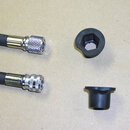Hi everyone
My diving has, and for the near future will be conducted at recreational depths and limits. However, I would like to progress into more advanced disciplines and I like to conduct my diving with a tech mindset.
I usually dive dry, hybrid jacket/ wing bc, steel single back and slung al40 pony.
Having read many books and accident reports as well as forums, I have never heard of a diver ascending prematurely due to a stuck inflator valve. In open water training we practiced disconnecting lp line to bc, I practiced many times disconnecting lp line to suit when learning to dive dry.
I'm not confident that if struck with a free flowing suit or bc inflator, I would recognize the situation quickly enough to recover. Especially my bc, it won't automatically vent like my suit, and the coupling is harder to access/operate.
Has anyone experienced or witnessed a situation like this? If so, what was the outcome? How do you prepare for and anticipate dealing with something like this?
How likely is this situation to actually occur? Any thoughts or comments on this would be appreciated.
Thanks for looking!
R
My diving has, and for the near future will be conducted at recreational depths and limits. However, I would like to progress into more advanced disciplines and I like to conduct my diving with a tech mindset.
I usually dive dry, hybrid jacket/ wing bc, steel single back and slung al40 pony.
Having read many books and accident reports as well as forums, I have never heard of a diver ascending prematurely due to a stuck inflator valve. In open water training we practiced disconnecting lp line to bc, I practiced many times disconnecting lp line to suit when learning to dive dry.
I'm not confident that if struck with a free flowing suit or bc inflator, I would recognize the situation quickly enough to recover. Especially my bc, it won't automatically vent like my suit, and the coupling is harder to access/operate.
Has anyone experienced or witnessed a situation like this? If so, what was the outcome? How do you prepare for and anticipate dealing with something like this?
How likely is this situation to actually occur? Any thoughts or comments on this would be appreciated.
Thanks for looking!
R





